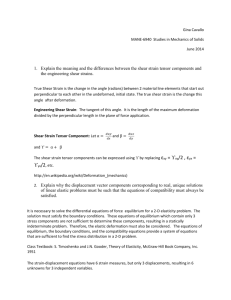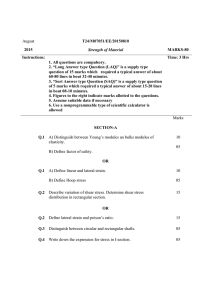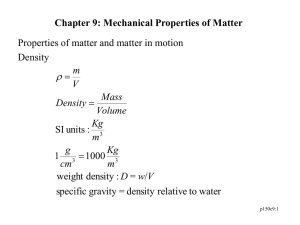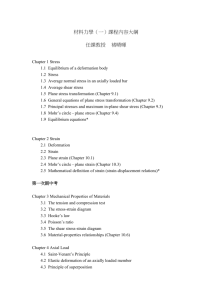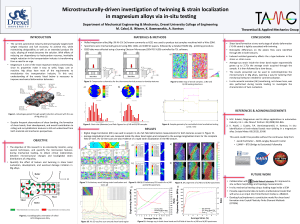A Report on the Disparity Encountered between Semi-analytical and ABAQUS... for a Simple Shear Process.
advertisement
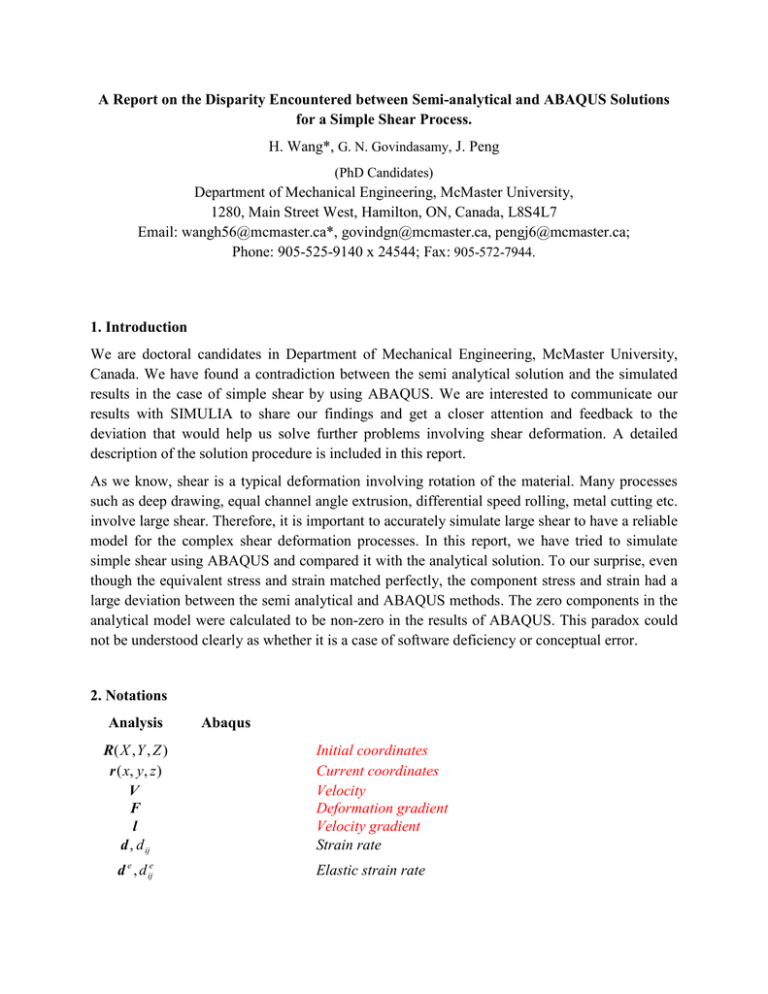
A Report on the Disparity Encountered between Semi-analytical and ABAQUS Solutions for a Simple Shear Process. H. Wang*, G. N. Govindasamy, J. Peng (PhD Candidates) Department of Mechanical Engineering, McMaster University, 1280, Main Street West, Hamilton, ON, Canada, L8S4L7 Email: wangh56@mcmaster.ca*, govindgn@mcmaster.ca, pengj6@mcmaster.ca; Phone: 905-525-9140 x 24544; Fax: 905-572-7944. 1. Introduction We are doctoral candidates in Department of Mechanical Engineering, McMaster University, Canada. We have found a contradiction between the semi analytical solution and the simulated results in the case of simple shear by using ABAQUS. We are interested to communicate our results with SIMULIA to share our findings and get a closer attention and feedback to the deviation that would help us solve further problems involving shear deformation. A detailed description of the solution procedure is included in this report. As we know, shear is a typical deformation involving rotation of the material. Many processes such as deep drawing, equal channel angle extrusion, differential speed rolling, metal cutting etc. involve large shear. Therefore, it is important to accurately simulate large shear to have a reliable model for the complex shear deformation processes. In this report, we have tried to simulate simple shear using ABAQUS and compared it with the analytical solution. To our surprise, even though the equivalent stress and strain matched perfectly, the component stress and strain had a large deviation between the semi analytical and ABAQUS methods. The zero components in the analytical model were calculated to be non-zero in the results of ABAQUS. This paradox could not be understood clearly as whether it is a case of software deficiency or conceptual error. 2. Notations Analysis R( X , Y , Z ) r ( x, y , z ) V F l d , d ij d e , d ije Abaqus Initial coordinates Current coordinates Velocity Deformation gradient Velocity gradient Strain rate Elastic strain rate d p , d ijp d Plastic strain rate p e Equivalent plastic strain rate Spin w , wij ε, ε ij LE. LEij ε ep σ , σ ij PEEQ S. Sij Equivalent plastic strain Cauchy stress ∇ σ σe τ , σ 12 γ µ, λ True strain S. Mises S12 E ν δ σ0 n Jaumann rate of Cauchy stress von Mises stress Shear stress Engineering shear strain Lamè constants Young's modulus Poisson's ratio Krokener delta Yielding stress Plastic working hardening exponent 3. Analysis Procedure 3.1 Formulation of simple shear Consider a body that undergoes a simple shear with a shear stress τ acting as shown in Fig.1. The undeformed body is a 1 X 1 square. τ γ Figure 1. Schematic of simple shear The boundary conditions assigned are, restriction of horizontal and vertical displacement of the bottom edge and vertical displacement of top edge. By this the top edge is free to move in horizontal direction. The deformation is characterized by the deformation gradient tensor F and velocity gradient tensor l : F= ∂r ∂R (i) l= ∂v ∂X (ii) where R( X , Y , Z ) is the initial coordinate of a point in the reference configuration; r ( x, y, z ) is the current coordinate of the point in the deformed configuration; V is the velocity of point r in the deformed configuration. For the case of simple shear, according to the boundary conditions assigned, the relation between r ( x, y, z ) and R( X , Y , Z ) are: x = X + Y tan γ y =Y (iii) z=Z And the velocity V is: V x = Y (sec γ ) 2 γ Vy = 0 (iv) Vz = 0 Therefore the deformation gradient tensor F is obtained: 1 tan γ F = 0 1 0 0 0 0 1 (v) And velocity gradient tensor l : 0 (sec γ ) 2 γ 0 l = 0 0 0 0 0 0 (vi) The velocity gradient can be decomposed into symmetric part d (strain rate) and asymmetrical part w (spin): 0 (sec γ ) 2 γ 2 0 1 d = (l + l T ) = (sec γ ) 2 γ 2 0 0 2 0 0 0 (vii) 0 (sec γ ) 2 γ 2 0 1 w = (l − l T ) = − (sec γ ) 2 γ 2 0 0 2 0 0 0 (viii) Because the plasticity are rate independent, the non-zero strain rate and spin can be assigned as d 12 = d 21 = γ 2 , w12 = − w21 = γ 2 . The strain rate d ij is decomposed to the elastic and plastic parts, d ij = d ije + d ijp . In order to consider large deformation, the large deformation constitutive equation is defined by: ∇ σ + tr (d )σ = 2 µ (d − d p ) + λtr (d − d p )δ (1) which is also used by ABAQUS for isotropic materials at large deformation, where λ = Eν (1 + ν )(1 − 2ν ) and µ = E / 2(1 + ν ) are the Lamè constants in terms of the Young's ∇ modulus E and the Poisson's ratio ν , δ is the Kronecker’s delta and σ is the Jaumann rate of the Cauchy stress tensor based on the spin w : ∇ σ = σ − w ⋅ σ + σ ⋅ w (2) 1 The plastic strain rate d ijp is proportional to the the deviatoric stress σ ij′ (= σ ij − σ kk δ ij ) as in the 3 conventional J 2 -flow theory of plasticity. The plastic strain rate can otherwise be expressed as, d ijp = 3d ep σ ij′ 2σ e (3) 3 σ ij′ σ ij′ is the von Mises effective stress and d ep = 2 plastic strain rate. The material hardening is defined by where σ e = σ Y = σ 0 f (ε ep ) = σ 0 (1 + Eε ep σ0 )n 2 p p d ij d ij is the equivalent 3 (4) where σ Y and σ 0 are the flow stress and yielding stress, respectively. ε ep is the equivalent plastic ∫ strain defined as ε ep = d ep dt . For the case of simple shear (Fig. 1), the non-zero strain rate and spin are d12 = d 21 = γ 2 , w12 = − w21 = γ 2 . From Eqs. (1), (3) and considering dkk=0, the stress rates are obtained as, σ 11 − γσ 12 = 2µ (0 − d11p ) = − σ 22 + γσ 12 = 2 µ (0 − d 22p ) = − σ 33 = 2 µ (0 − d 33p ) = − 3µd ep σe σ 11 (5a) σ 22 (5b) 3µd ep σe 3µd ep σe σ 33 3µd ep γ γ σ 12 + (σ 11 − σ 22 ) = 2 µ ( − d12p ) = µγ − σ 12 2 2 σe (5c) (5d) From Eqs. (5a-c), it can be derived that σ 33 is always zero and σ 11 = −σ 22 . Therefore, Eq. (5) can be rewritten as: σ 11 = γσ 12 − 3µd ep σe σ 12 = ( µ − σ 11 )γ − σ 11 3µd ep σe σ 12 (6a) (6b) If the material is in elastic region, d ep is zero. This implies, σ 11 = σ 12 γ and σ 12 = ( µ − σ 11 )γ . If the material is in plastic region, the consistency condition, σ e = σ Y , requires that d ep = σ e / σ 0 f ' (ε ep ) . For simple shear, σ e = 3(σ 112 + σ 122 ) , σ e = 3(σ 11σ 11 + σ 12σ 12 ) σ e . Therefore, the equivalent plastic strain rate can be written as: d ep = 3(σ 11σ 11 + σ 12σ 12 ) σ eσ 0 f ' (ε ep ) (7) Then Eq. (6) can be rewritten as: σ 11 = γσ 12 − 9 µσ 112 σ 11 9 µσ σ σ − 2 11 12 p12 2 p σ e σ 0 f ' (ε e ) σ e σ 0 f ' (ε e ) σ 12 = −γσ 11 + µγ − By denoting A = 9 µσ 11σ 12σ 11 9 µσ 122 σ 12 − σ e2σ 0 f ' (ε ep ) σ e2σ 0 f ' (ε ep ) (8a) (8b) 9µ , eq. (8) can be rewritten as: σ σ 0 f ' (ε ep ) 2 e (1 + Aσ 112 )σ 11 + Aσ 11σ 12σ 12 = σ 12 γ (9a) Aσ 11σ 12σ 11 + (1 + Aσ 122 )σ 12 = ( µ − σ 11 )γ (9b) (1 + Aσ 122 )σ 12 − Aσ 11σ 12 ( µ − σ 11 ) σ 11 = γ 1 + A(σ 112 + σ 122 ) (10a) Therefore, σ 12 (1 + Aσ 112 )( µ − σ 11 ) − Aσ 11σ 122 = γ 1 + A(σ 112 + σ 122 ) (10b) The material constants are assumed as: E=500, ν=0.33, σ0=1 and n=0.2. Substituting these constants in eq. (10), the solution can be obtained semi-analytically. The same problem was simulated with ABAQUS. The boundary conditions assigned are, restriction of horizontal and vertical displacement of the bottom edge and vertical displacement of top edge. By this the top edge is free to move in horizontal direction. In order to avoid the interaction between the elements, only one element (element type is CPE4R) is considered for calculation. The corresponding input file codes, <shear.inp> is included in the appendix. 4. Comparison between the results by semi-analytical solution and ABAQUS methods. Fig.2 shows the calculated Von Mises stress versus equivalent plastic strain curves obtained through semi-analytical and ABAQUS methods. Both curves are found to be in close agreement. Similar agreement is found with the shear stress versus equivalent plastic strain and normal stress component versus equivalent plastic strain as shown in Fig.3 and Fig.4 respectively. However, if the stress values are compared against the individual strain components, there is a considerable difference between the semi-analytical and ABAQUS methods. Fig. 5, 6 and 7 show the Von Mises stress, shear stress and component normal stress plotted against the component shear strain explaining this paradox. Secondly, the normal strain component is overestimated by ABAQUS which is obviously zero as obtained by analytical method (Fig.8). 5. Conclusion Provided the correctness of semi analytical solution, there exists a lacuna in obtaining effective stress and strain for a simple shear deformation through ABAQUS simulation. We have counter checked the simulation in various versions of ABAQUS, namely 6.5-4, 6.7-1, 6.8-3 versions and also in different processors. Other element types such as, CPS4, CPS4R, CPE4, CPE4RH, CPE8I, and CPE8R have been also tried. The results are found to be consistently same in all the cases. Therefore, we decided to write this report and communicate it to SIMULIA to obtain a clearer understanding of the contradiction. We have also communicated our results to other academic experts in the field to get their opinion on this situation. We request for your kind attention to this problem and give us your valuable feedback that would help us solve further problems in plasticity involving complex shear deformation. Your support in this matter is well appreciated. 4 σe 3 2 Semi-Analytical ABAQUS 1 0 0 0.2 0.4 ε ep Figure 2. Plot of Von Mises stress versus equivalent plastic strain. 0.6 2 τ 1.5 1 Semi-Analytical ABAQUS 0.5 0 0 0.2 0.4 ε ep 0.6 Figure 3. Plot of shear stress versus equivalent plastic strain. 0.02 σ 11 0.015 0.01 Semi-Analytical ABAQUS 0.005 0 0 0.2 0.4 ε ep 0.6 Figure 4. Plot of normal stress component versus equivalent plastic strain. 4 σe 3 2 Semi-Analytical ABAQUS 1 0 0 0.2 0.4 0.6 0.8 1 ε 12 (γ / 2) Figure 5. Plot of Von Mises stress versus shear strain component 2 τ 1.5 1 Semi-Analytical ABAQUS 0.5 0 0 0.2 0.4 0.6 0.8 ε 12 (γ / 2) Figure 6. Plot of shear stress versus shear strain component 1 0.02 σ 11 0.015 0.01 Semi-Analytical ABAQUS 0.005 0 0 0.2 0.4 0.6 0.8 ε 12 (γ / 2) 1 Figure 7. Plot of normal stress component versus shear strain component. ε 11 0.25 0.2 0.15 Semi-Analytical ABAQUS 0.1 0.05 0 0 0.2 0.4 0.6 0.8 ε 12 (γ / 2) 1 Figure 8. Plot of normal strain component and shear strain component. Appendix <Shear.inp> *Heading ** Job name: shear Model name: abq67_shear *Preprint, echo=NO, model=NO, history=NO, contact=NO ** ** PARTS ** *Part, name=Part-1 *End Part ** ** ** ASSEMBLY ** *Assembly, name=Assembly ** *Instance, name=Part-1-1, part=Part-1 *Node 1, 0.5, -0.5 2, -0.5, -0.5 3, 0.5, 0.5 4, -0.5, 0.5 *Element, type=CPE4R 1, 4, 2, 1, 3 *Nset, nset=_PickedSet2, internal, generate 1, 4, 1 *Elset, elset=_PickedSet2, internal 1, ** Section: Section-1 *Solid Section, elset=_PickedSet2, material=MATERIAL-1 1., *End Instance ** *Nset, nset=_PickedSet10, internal, instance=Part-1-1 1, 2 *Elset, elset=_PickedSet10, internal, instance=Part-1-1 1, *Nset, nset=_PickedSet15, internal, instance=Part-1-1 1, 2 *Elset, elset=_PickedSet15, internal, instance=Part-1-1 1, *Nset, nset=_PickedSet16, internal, instance=Part-1-1 3, 4 *Elset, elset=_PickedSet16, internal, instance=Part-1-1 1, *End Assembly ** ** MATERIALS ** *Material, name=MATERIAL-1 *Elastic 500., 0.33 *Plastic 1., 0. 1.43097, 0.01 1.61539, 0.02 1.7411, 0.03 1.83842, 0.04 1.91865, 0.05 1.98734, 0.06 2.04767, 0.07 2.10163, 0.08 2.15056, 0.09 2.1954, 0.1 2.23685, 0.11 2.27544, 0.12 2.31158, 0.13 2.34559, 0.14 2.37773, 0.15 2.40822, 0.16 2.43725, 0.17 2.46495, 0.18 2.49146, 0.19 2.51689, 0.2 2.54133, 0.21 2.56487, 0.22 2.58757, 0.23 2.6095, 0.24 2.63072, 0.25 2.65127, 0.26 2.67121, 0.27 2.69057, 0.28 2.70938, 0.29 2.72769, 0.3 2.74552, 0.31 2.7629, 0.32 2.77985, 0.33 2.7964, 0.34 2.81256, 0.35 2.82837, 0.36 2.84382, 0.37 2.85895, 0.38 2.87376, 0.39 2.88828, 0.4 2.90251, 0.41 2.91646, 0.42 2.93016, 0.43 2.9436, 0.44 2.9568, 0.45 2.96977, 0.46 2.98251, 0.47 2.99505, 0.48 3.00737, 0.49 3.0195, 0.5 3.03143, 0.51 3.04318, 0.52 3.05475, 0.53 3.06615, 0.54 3.07738, 0.55 3.08845, 0.56 3.09937, 0.57 3.11013, 0.58 3.12075, 0.59 3.13122, 0.6 3.14155, 0.61 3.15175, 0.62 3.16182, 0.63 3.17177, 0.64 3.18158, 0.65 3.19129, 0.66 3.20087, 0.67 3.21034, 0.68 3.2197, 0.69 3.22895, 0.7 3.2381, 0.71 3.24714, 0.72 3.25609, 0.73 3.26494, 0.74 3.27369, 0.75 3.28235, 0.76 3.29092, 0.77 3.2994, 0.78 3.3078, 0.79 3.31611, 0.8 3.32434, 0.81 3.33249, 0.82 3.34056, 0.83 3.34855, 0.84 3.35646, 0.85 3.36431, 0.86 3.37208, 0.87 3.37977, 0.88 3.3874, 0.89 3.39497, 0.9 3.40246, 0.91 3.40989, 0.92 3.41725, 0.93 3.42456, 0.94 3.4318, 0.95 3.43897, 0.96 3.4461, 0.97 3.45316, 0.98 3.46016, 0.99 3.46711, 1. ** ---------------------------------------------------------------** ** STEP: Step-1 ** *Step, name=Step-1, nlgeom=YES *Static 0.0001, 1., 1e-05, 0.02 ** ** BOUNDARY CONDITIONS ** ** Name: BC-1 Type: Displacement/Rotation *Boundary _PickedSet15, 1, 1 _PickedSet15, 2, 2 ** Name: BC-2 Type: Displacement/Rotation *Boundary _PickedSet16, 1, 1, 1. _PickedSet16, 2, 2 ** ** OUTPUT REQUESTS ** *Restart, write, frequency=0 ** ** FIELD OUTPUT: F-Output-1 ** *Output, field, variable=PRESELECT ** ** HISTORY OUTPUT: H-Output-1 ** *Output, history, variable=PRESELECT *End Step


